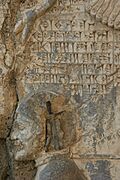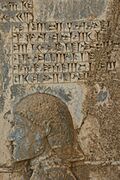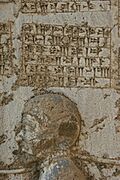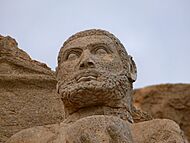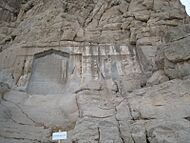Behistun Inscription facts for kids
| UNESCO World Heritage Site | |
|---|---|
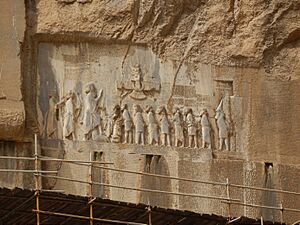
This carving shows Darius the Great punishing people who lied and rebelled against him. The person under Darius's foot is Gaumāta. The last person in line, wearing a special hat, is Skunkha. His image was added later, so some text had to be removed.
|
|
| Location | Mount Behistun, Kermanshah Province, Iran |
| Criteria | Cultural: ii, iii |
| Inscription | 2006 (30th Session) |
| Area | 187 ha |
| Buffer zone | 361 ha |
The Behistun Inscription (also known as Bisotun) is a very old and important carving on a huge rock cliff in Iran. It's like a giant history book carved into stone! This amazing monument was created by Darius the Great, a powerful king of the Persian Empire, around 2,500 years ago.
What makes it so special? It's the longest known inscription written in three different ancient languages using cuneiform writing: Old Persian, Elamite, and Babylonian. Because it was written in three languages, it became a super important "Rosetta Stone" that helped experts finally understand how to read ancient cuneiform scripts!
Contents
The Great's Story in Stone
King Darius the Great had this inscription made sometime between 522 BC and 486 BC. It starts with a short story about Darius himself, telling us about his family and where he came from.
But the main part of the inscription is a long and exciting account of how Darius fought many battles to take control of the Persian Empire. After the previous king, Cambyses II, died, several people tried to pretend they were the rightful king, causing lots of trouble across the empire. Darius explains in detail how he fought 19 battles in just one year (ending in December 521 BC) to defeat these impostors and stop the rebellions. He proudly states that he won every single battle, and he gives credit for his success to his god, Ahura Mazda.
How Big is the Behistun Inscription?
The Behistun Inscription is huge! It's about 15 meters (50 feet) high and 25 meters (82 feet) wide. It's carved high up on a limestone cliff, about 100 meters (330 feet) above an ancient road that connected important cities like Babylon and Ecbatana.
The text itself is very long:
- The Old Persian part has 414 lines in five columns.
- The Elamite part has 260 lines in eight columns.
- The Babylonian part has 112 lines.
Next to the writing, there's a life-sized carving (called a bas-relief) of Darius the Great. He's holding a bow, which shows he's king. His left foot is on the chest of a figure lying down, who is believed to be Gaumata, one of the impostors Darius defeated. To Darius's left, there are two servants, and to his right, there are nine figures standing with their hands tied and ropes around their necks. These represent the leaders of the conquered peoples. Above them, a winged figure called a Faravahar floats, giving its blessing to the king. It's interesting to note that one of the figures and Darius's beard seem to have been added later, showing how the carving was updated over time!
What Does "Behistun" Mean?
The name "Behistun" comes from ancient Greek and Arabic writings. In modern Persian, the name is "Bisotun." Both names refer to this incredible historical site.
Who Discovered and Translated the Inscription?
Early European Visitors to Behistun
After the Persian Empire declined, people forgot what the Behistun Inscription was all about. For a long time, people came up with all sorts of imaginative stories about it.
- In 1598, an Englishman named Robert Sherley saw the inscription and told other European scholars about it. However, his group mistakenly thought it was Christian.
- Later, others thought it showed "Christ and his twelve apostles" or even the Lost Tribes of Israel.
- In 1604, an Italian explorer named Pietro della Valle visited and made some early drawings of the monument.
How the Behistun Inscription Was Deciphered
The Behistun Inscription played a key role in understanding ancient cuneiform writing.
- Around 1764, a German surveyor named Carsten Niebuhr made a copy of the inscription. His copies were later used by scholars like Georg Friedrich Grotefend.
- By 1802, Grotefend had figured out ten of the 37 symbols of Old Persian cuneiform. He realized that, unlike some other cuneiform scripts, Old Persian was alphabetic (each symbol represented a sound) and words were separated by a special symbol.
The real breakthrough came with Sir Henry Rawlinson.
- In 1835, Sir Henry Rawlinson, a British army officer, began seriously studying the inscription. Even though it was very hard to reach, Rawlinson managed to climb the cliff with the help of a local boy and copy the Old Persian text.
- The Elamite and Babylonian texts were even harder to get to, high above a deep gap. Rawlinson worked on them later.
- By 1847, he was able to send a complete and accurate copy of the inscription to Europe. This was a huge step, as having the same text in three different languages allowed scholars to compare them and finally crack the code of cuneiform!
What Happened to the Inscription Later?
Over the years, many researchers have visited the Behistun Inscription to study it more closely:
- In 1903, American linguist A. V. Williams Jackson visited the site.
- Later expeditions, including those sponsored by the British Museum (1904) and the University of Michigan (1948), took photographs, made casts, and created even more accurate copies of the texts.
- Researchers also noticed that rainwater had damaged some parts of the inscription by dissolving the limestone, while new limestone deposits had covered other parts of the text.
Sadly, the monument also suffered some damage during the 20th century:
- During World War II, some Allied soldiers used it for target practice, and it was also affected during the Anglo-Soviet invasion of Iran.
In recent years, Iranian archaeologists have been working hard to protect and restore the site:
- In 1999, Iranian archaeologists started documenting and assessing the damage. They used a special technique called Photogrammetry to take 2D photos and turn them into 3D images of the inscriptions.
- Since then, they have been doing important conservation work.
- In 2006, the Behistun Inscription was recognized as a World Heritage Site by UNESCO, which means it's considered very important for all of humanity and deserves special protection.
- In 2012, the Bisotun Cultural Heritage Center organized an international project to study the inscription again with new technologies.
What Does the Inscription Say?
Darius's Royal Family Tree
In the first part of the inscription, King Darius proudly explains his family history:
King Darius says: My father is Hystaspes; the father of Hystaspes was Arsames; the father of Arsames was Ariaramnes; the father of Ariaramnes was Teispes; the father of Teispes was Achaemenes.
King Darius says: That is why we are called Achaemenids; from ancient times we have been noble; from ancient times has our dynasty been royal.
King Darius says: Eight of my family were kings before me; I am the ninth. Nine in a row we have been kings.
King Darius says: By the grace of Ahuramazda am I king; Ahuramazda has granted me the kingdom.
This shows that Darius believed his right to rule came from a long line of kings and from the blessing of his god, Ahura Mazda.
Countries Under Darius's Rule
Darius also lists all the lands and peoples that were part of his vast empire:
King Darius says: These are the countries which are subject unto me, and by the grace of Ahuramazda I became king of them: Persia, Elam, Babylonia, Assyria, Arabia, Egypt, the countries by the Sea (Phoenicia), Lydia, the Greeks, Media, Armenia, Cappadocia, Parthia, Drangiana, Aria, Chorasmia, Bactria, Sogdia, Gandhara, Scythia, Sattagydia, Arachosia and Maka; twenty-three lands in all.
This list gives us a great idea of how large and powerful the Persian Empire was under Darius.
Battles and Rebellions Darius Faced
The inscription then describes the many conflicts Darius faced and won. He tells us about the rebellions that happened after the death of the previous king, and how he defeated the impostors who tried to claim the throne. The carvings next to the text show some of these defeated leaders:
-
This is ššina, who lied about being king of Elam. -
This is Nidintu-Bêl, who lied about being Nebuchadnezzar, king of Babylon. -
This is Frâda, who lied about being king of Margiana.
-
This is Skunkha the Sacan.
Other Historical Sites at Behistun
The Behistun area is much more than just Darius's inscription! It covers a large area of 116 hectares, and archaeologists have found evidence that people lived here as far back as 40,000 years ago. Besides the famous inscription, there are 18 other historical monuments in the Behistun complex that are important national sites in Iran. Some of these include:
|
|
-
Bas reliefs of Mithridates II of Parthia and Gotarzes II of Parthia.
Similar Ancient Carvings
Yes! The Behistun Inscription might have been inspired by an even older carving called the Anubanini rock relief. This relief, made by King Anubanini around 2300 BC, is located not far from Behistun. It shows a ruler trampling an enemy and lines of prisoners, which is very similar to the Behistun carvings. It's believed that the artists who created the Behistun Inscription probably saw the Anubanini relief and were influenced by it.
The tradition of carving important inscriptions, especially by kings like Darius I, likely came from earlier cultures in the region, including the Elam, Lullubi, Babylonians, and Assyrians.
See also
- Darius I of Persia
- Achaemenid Empire
- Taq-e Bostan (Other famous rock reliefs in Iran)
- Pasargadae (Where Cyrus the Great is buried)
- Anubanini rock relief (An older, similar carving)



